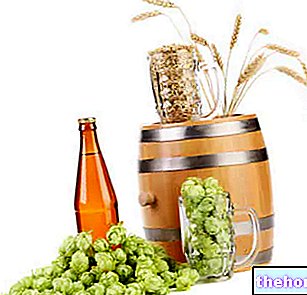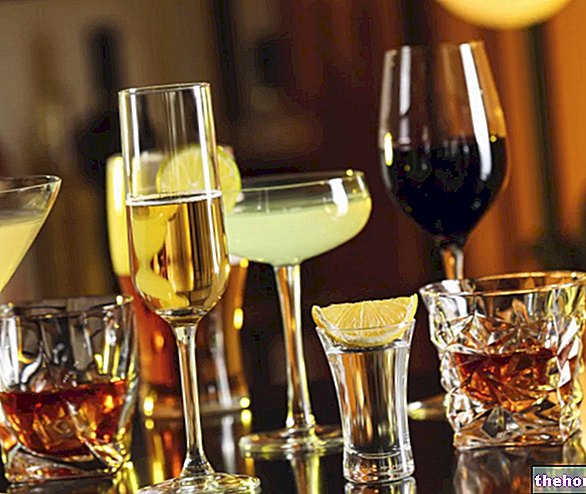So is the Alchermes

Alchermes is red, medium alcoholic (about 30 °) and quite sweet. Its basic ingredients are: water, cinnamon, cochineal (red coloring additive of animal origin), mace, cloves, cardamom, vanilla, water roses, granular sugar and pure alcohol (95 °).
Recipe
Alchermes ingredients (from Wikipedia)- 350 g of ethyl alcohol at 95 °
- 350 g of sugar
- 500 g of water
- 5 g cinnamon sticks
- 4 g of cochineal
- 1 g of cloves
- 1 g of cardamom
The alchermes recipe can also be reproduced at home; the procedure is simple:
- leave the spices to soak in alcohol and 2 dl of water, inside an airtight container, for about 15 days (shaking it twice a day).
- Dissolve the sugar in 3 dl of boiling water and (after letting it cool) add everything to the macerate; let it rest for a day.
- Filter and bottle adding the rose water.
Discover the video recipe for Christmas Biscuits - Peschine all "alchermes - below the preview of the video
Christmas cookies - Peaches all "Alchermes
Problems with playing the video? Reload the video from youtube.
- Go to the Video Page
- Go to the Video Recipes Section
- Watch the video on youtube
Use of alchermes
Alchermes is a liqueur widely used in pastry for the preparation of baths, for soaking, for coloring bases and creams, etc.
At one time, the "alchermes was also widely used in direct consumption (especially by the female sex) but, both for the excessively" caramel "flavor, and for a rejection of the cochineal dye (extracted from insects), at day d" today it is no longer a customary drink.
In the past centuries, the alchermes has also played the role of "elixir" (soothing and antispasmodic against whooping cough, neuralgic affections, renal colic and retention of urine) and of vermifuge, but it is simply a matter of popular legends. To date, alchermes is still used (fortunately in an extremely localized way) as a remedy for "worms" in children who, according to certain equally folkloric beliefs, should arise as a result of great fright. Probably it is a diversion to be able to administer the "sedative" to overly capricious children.

Nutritional values
What instead appears certain and obvious is that the promotion of the consumption of alchermes (as spirits) in the very young is absolutely contraindicated and inadvisable, as it predisposes the subjects to appreciate both the taste and the effects of nervine drinks.
It is curious to learn that alchermes is present among the ingredients of a particular sausage: mortadella di Prato.
Background
The term alchermes derives from Sanskrit (Indian language) krmi-ja, evolved into Arabic al-qirmiz and in Spanish alquermes. Krmi-ja is intended as a "red drink" (as well as kermes And qirmiz), from whose name the Latin-medieval terms derive crimson And carmine. In a literate sense, krmi-ja And qirmiz mean "worm" and "cochineal" (Kermes vermilio).
The first uses of the cochineal dye are to be located in Mesopotamia (2nd millennium BC); from here, it was then spread to Persia, Turkey and Palestine and finally to Europe (8th century BC). It is not so easy to identify the historical period in which the recipe of the famous liqueur was invented, but it is certain that in Italy the alchermes arrived thanks to the Spanish import (people who obtained the recipe from the Arabs themselves). In the Bel Paese, the production of alchermes is documented starting from the Middle Ages by the nuns of the Order of Santa Maria dei Servi (Florence). Later, the director of the workshop, friar Cosimo Bucelli, formalized the original recipe handed down to the our days; the peak of sales and diffusion would seem to be in the 19th century AD.
Nutritional composition
On the INRAN food composition tables, the "alchermes is NOT a food in its own right but is listed under the heading Dessert liqueurs. There is not much to say about its composition: it is a spirit with a very high sugar and caloric content. . Both simple carbohydrates and alcohol represent molecules with a highly insulin-stimulating power, which is why alchermes (like all liqueurs) is a potentially fattening drink. There are no chemical-nutritional qualities and the medium portion recommended (so to speak) for adults is about 125ml / day.
Other Alcoholic Alchermes Alcohol test Alcopops Cocktail Alcoholic Alcoholic units calculation Cognac Gin Grappa Alcoholic degree Grappa Limoncino Maraschino Marsala Nocino Prosecco Rum Rum Sherry Sparkling wine Spirits Wine Port wine Vermouth Vodka Vov Whiskey Categories Alcoholic foods Meat Cereals and derivatives Sweeteners Sweets Offal Dried fruit Milk and derivatives Legumes Oils and fats Fish and fishery products Cold cuts Spices Vegetables Health recipes Appetizers Bread, Pizza and Brioche First courses Second courses Vegetables and salads Sweets and desserts Ice creams and sorbets Syrups, liqueurs and grappas Basic preparations ---- In the kitchen with Leftovers Carnival recipes Christmas recipes Light diet recipes Women's, mom's and dad's day recipes Functional recipes International recipes Easter recipes Celiac recipes Diabetic recipes Holiday recipes Valentine's Day recipes Vegetarian recipes Protein recipes Regional recipes Vegan recipes



























